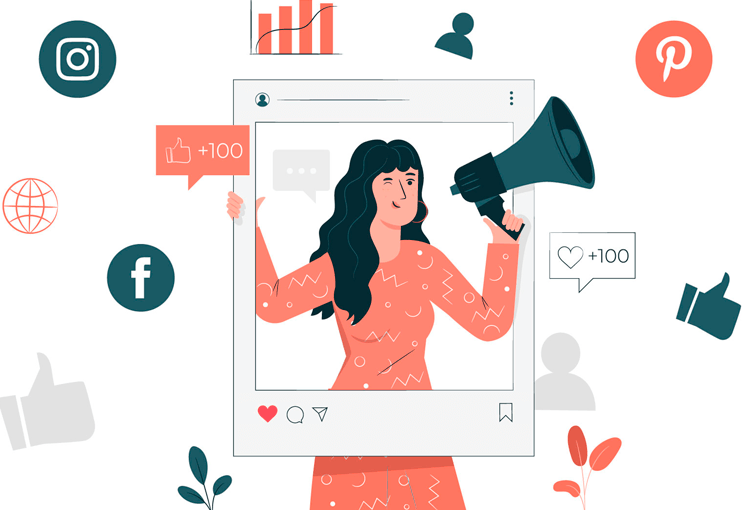In today’s digital world, social media has reshaped how businesses connect with audiences. It’s not just about products or services anymore—it’s about building relationships, fostering trust, and making your brand a recognized name.
For brands aiming to become online “influencers,” understanding how to build a significant social media presence and capture attention is essential.
Whether you’re a small business owner, a marketer, or a content creator, becoming better online means you’ll benefit from increased visibility, better engagement, and, ultimately, a stronger connection with your audience. In this article, we’ll explore how to make your brand the next influencer and the benefits it brings to your business.
1. Building Credibility and Trust with Your Audience
When a brand becomes an influencer, it doesn’t happen overnight. It involves consistent and authentic communication with an audience. Authenticity is the keyword here, as 90% of consumers say that authenticity is important when deciding which brands they like and support. By aligning your brand voice with the values of your audience and engaging genuinely, your brand builds a sense of trust that’s hard to replicate through traditional advertising.
For example, skincare brand Glossier achieved influencer status by sharing real-life stories from its customers and maintaining a conversational tone on social media. This approach helped them build credibility and resonated with people looking for honest beauty solutions. Embracing this strategy can enable your brand to become not only more trusted but also better known across online communities.
Actionable Tip:
Post regularly with valuable, helpful, or entertaining content to keep your brand top of mind. Show your audience that your brand’s personality aligns with theirs, which will encourage a strong, trusting bond.
2. Increasing Engagement Rates with Your Content
Engagement is more than just likes and comments—it’s about how involved your audience is with your content. Brands that establish themselves as influencers typically see higher engagement rates because their followers feel a deeper connection to the brand. Engaging content invites followers to interact, share, and talk about the brand, creating a ripple effect that spreads across social media.
Consider Nike, a brand that consistently goes viral on social media by connecting with its audience through motivational content. By sharing stories of athletes, personal growth, and community impact, Nike’s brand resonates with people who identify with these values. The result? Thousands of comments, shares, and loyal followers who engage regularly with Nike’s social media presence.
Actionable Tip:
Encourage engagement by posting interactive content, like polls, question prompts, or user-generated content. Make your audience feel that they are part of your journey, and they’ll be more likely to stick around and interact with you.

3. Expanding Reach with Influencer Status
When a brand becomes a recognized influencer, the reach extends beyond its own social media followers. This broader reach is achieved through collaborations, partnerships, and earned media, as other accounts may share or reference your brand. In fact, studies show that brands with a large social media following are 67% more likely to attract collaboration offers from other businesses and influencers.
As an example, Starbucks often collaborates with influencers and popular personalities to promote new drinks or limited-time offers. These partnerships create hype and encourage a wide range of followers to try out their products. For a small business, these kinds of collaborations might be on a smaller scale, but the impact can be equally powerful, bringing new eyes to your business.
Actionable Tip:
Reach out to micro-influencers agencies or other small brands whose audiences align with yours. Collaborating on social media can help both parties gain new followers and increase brand exposure without hefty advertising costs.
4. Attracting New Customers with Targeted Content
Becoming an influencer brand gives your business the advantage of drawing in new customers interested in your products or services. By tailoring content to appeal to the audience you want to attract, you can boost conversion rates and make your brand the top choice for potential customers. Studies show that 81% of people buy based on social media recommendations, meaning your content could directly impact buying decisions.
Take the example of the fashion brand Fashion Nova, which became a massive influencer by working with Instagram influencers to showcase their clothing. They didn’t just showcase their products; they also shared styling tips, fashion trends, and body positivity messages that resonated with their target demographic. This relatable, value-driven approach pulled in a steady stream of new customers who wanted to identify with the brand’s ethos.
Actionable Tip:
Create buyer personas and develop content that speaks to those personas. Think about the problems your audience faces and position your brand as a solution, driving new customers toward your products.
5. Increasing Sales and Revenue
When your brand gains attention online and becomes an influencer, it naturally attracts more sales. Businesses that have a well-established online presence tend to have higher conversion rates, as people trust recommendations from brands they follow and admire. Social media can also drive traffic to your website or store, leading to more purchases.
For example, Gymshark, a fitness apparel brand, saw rapid growth after collaborating with fitness influencers. Their social media presence wasn’t just about selling products; they offered workout tips, nutrition advice, and community support, becoming a go-to brand for fitness enthusiasts. This positioning translated into increased sales, as customers flocked to their website and purchased Gymshark gear to be part of that community.
Actionable Tip:
Share content that not only showcases your product but also highlights the lifestyle or value it provides. Include direct calls to action, encouraging viewers to check out your website, browse your catalog, or use a limited-time offer.
6. Boosting SEO and Online Visibility
A strong social media presence can do wonders for your website’s SEO and overall online visibility. By regularly posting engaging content, using keywords effectively, and driving traffic to your website, you improve your online footprint, which helps boost search engine rankings. Companies that actively use social media generate 45% more web traffic than those that do not.
Brands like HubSpot leverage social media as a way to boost their content marketing strategy. They share blog posts, educational videos, and infographics on their channels, all linking back to their website. This strategy has allowed HubSpot to drive a steady stream of organic traffic to their website, boosting their search engine ranking.
Actionable Tip:
Incorporate keywords and hashtags into your posts, and link back to your website. Share valuable content that solves your audience’s problems and positions your brand as an authority in the industry.

7. Building a Community Around Your Brand
A brand that functions as an influencer often fosters a community that goes beyond just buying and selling. This community creates loyal followers who advocate for your brand, recommend it to friends, and actively engage with its content. Building a community can also lead to valuable feedback, helping your business grow and adapt to changing customer needs.
Apple is an example of a brand that has created a strong community around its products. Their “Shot on iPhone” campaign not only promoted their phones but also encouraged users to share their own photos, creating a community of photographers and enthusiasts who continually support the brand.
Actionable Tip:
Encourage your audience to share their experiences, opinions, or ideas related to your brand. Showcase user-generated content on your social media and respond to comments to make followers feel valued and heard.
8. Gaining Insights and Adapting to Market Trends
Becoming an influential brand online also allows you to gather insights into customer preferences and stay ahead of market trends. Tools like social media analytics give you a clear picture of which content performs best and what your audience wants to see more of. This enables you to pivot your content strategy to better align with what’s currently resonating with users.
For example, Netflix uses social media to gauge audience interests and preferences, tailoring recommendations and promotions based on engagement patterns. This insight helps them adapt to market trends quickly, ensuring they remain relevant to their global audience.
Actionable Tip:
Use social media analytics to track your performance and identify areas for improvement. Regularly update your strategy to stay aligned with the latest trends and user interests.
Building a brand that becomes an online influencer doesn’t happen overnight, but with the right strategy, consistency, and focus on building relationships, any brand can grow its influence. By prioritizing engagement, collaboration, and authenticity, you can establish a brand that resonates deeply with your audience and drives real results for your business.
Want to learn more about becoming a better online influencer and mastering social media? For more expert tips on social media, content creation, and branding, check out irenekreations.com for all the resources you need to take your online presence to the next level!





